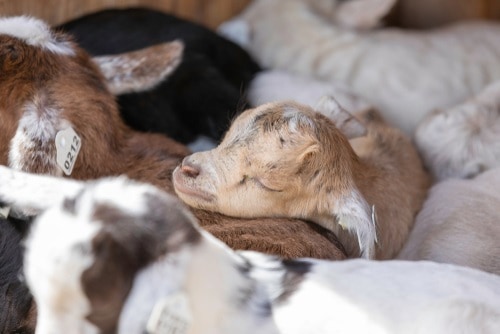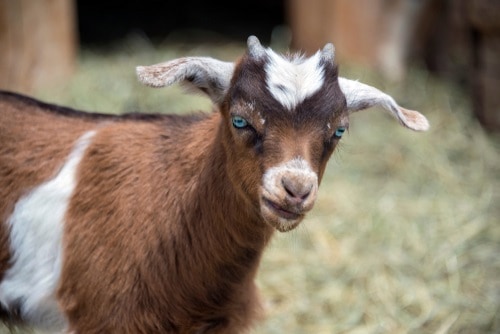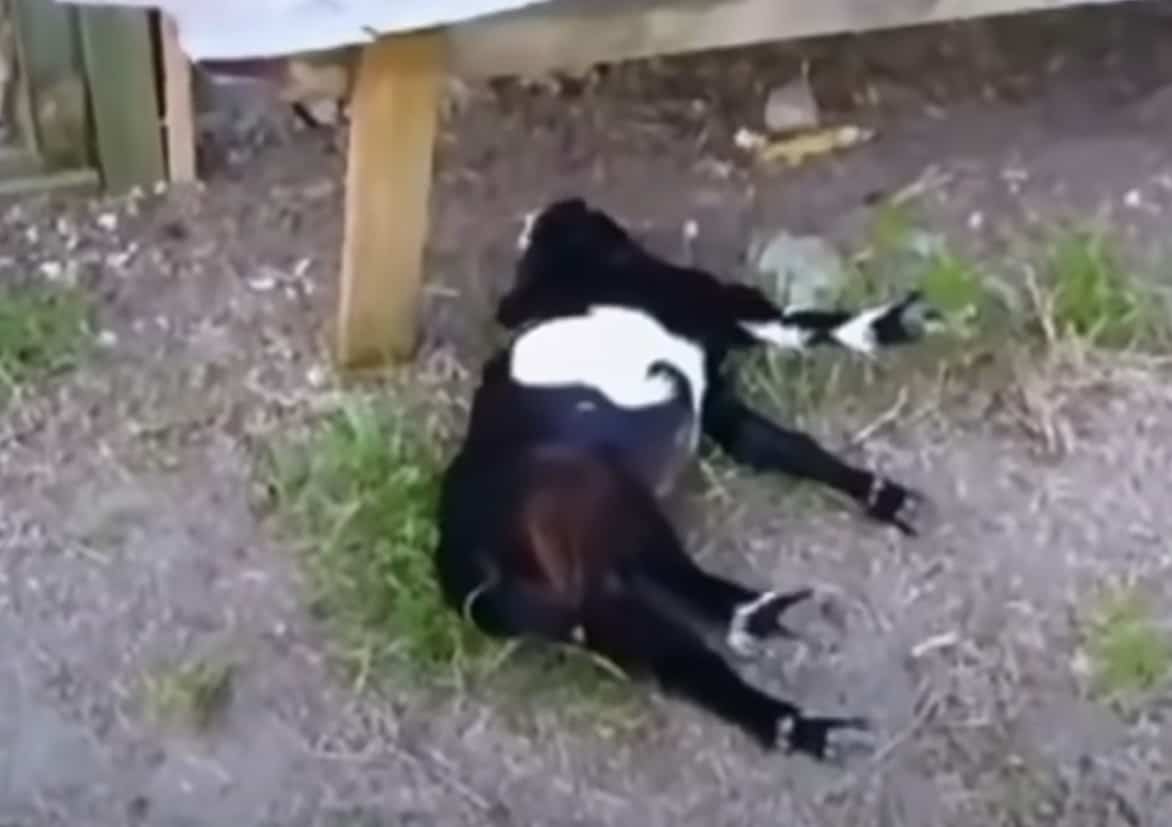Why do goats faint when they are startled? As you can imagine, every animal is born with a fight or flight instinct, and for prey animals like goats, the flight instinct is often stronger than the fight. However, some goats don’t run away when they are startled.
Instead, these goats start running, and then, somewhere along the way, they stiffen up and fall over, with their legs remaining rigid for a little while. They look as if they just fainted. That’s part of why they are called fainting goats.
So, are these goats really fainting, and if so, why do they faint, and is there anything that you, as the farmer, can do about it? We answer if it hurts when they faint and how this curiosity came about in some goats.
Why Do Goats Faint
If you have ever seen a goat faint, you have seen a myotonic goat. Fainting goats have a genetic condition called myotonic congenita. According to the International Fainting Goat Association, myotonia congenita is a neuromuscular disorder found in most animals, including goats, sheep, horses, and humans.
The muscles of animals that suffer from this condition can’t quickly relax once they have voluntarily contracted. As such, animals suffering from this condition develop the inability to move once they are startled.
Going back to the fight or flight response, myotonic goats have the same instincts as any other animal, and when they are frightened, their first response is to run away from the perceived danger. This action causes their muscles to contract rapidly in preparation for the flight.
Because they have myotonia congenita, these muscles don’t relax as quickly as they should, and the entire goat remains rigid mid-flight.
That’s why they often look like they are fainting. Fainting goats aren’t fainting at all. They can’t move. Strangely enough, they are conscious the entire time.
Myotonic goats are known by a host of other names, including:
- Stiff leg goats
- Wooden leg goats
- Nervous goats
- Scare goats

These goats first appeared in the US around 1880. However, there isn’t any clear indication of how the breed came about. Some speculation is that a natural gene mutation in a Tennessee goat herd led to this hereditary genetic disorder causing skeletal muscle stiffness in myotonic goats.
There are several other speculative explanations. Another is that a farmer and goat breeder, John Tinsley, brought four of these fainting goats to Marshall County in Tennessee from Nova Scotia, Canada. About a year later, another breeder named Dr. H.H. Mayberry bought these goats and raised a much bigger herd.
Dr. H.H. Mayberry then sold some of the resulting kids to nearby farmers. Since congenital myotonia is a hereditary condition, these younger goats had it, and as a result, more and more goat herds caught the condition. After a while, a goat breed called the Tennessee fainting goats spread across the South.

Fun Facts About Fainting Goats
There are several fun facts about these fainting goats that might surprise you.
Fun Fact #1: They Are Not Fainting
Despite being called fainting goats, myotonic goats do not actually faint or pass out. The hereditary condition Myotonia congenita renders the goats’ skeletal muscles stiff for a bit longer than they should be. This condition affects the goat’s hind legs most, so the goats can’t move when they are supposed to be running away.
Since they are often in mid-flight when the condition kicks in, the goats are off balance. As a result, they fall on their side, stiff as a log. That falling motion makes it seem as if the goats have fainted, but they are just stiff.
Myotonic goats are conscious during this ordeal and regain mobility after a short while. However, during the fainting, they are conscious and breathing just fine.
Fun Fact # 2: There’s an Official Myotonic Goat Registry
There’s an official Myotonic Goat Registry that was set up to keep track of the original myotonic goat breed across the US and Canada. This registry acts as the go-to information portal for breeders who have or want to keep fainting goats on their farms.
You are encouraged to register your fainting goats with the registry, whether you have a single pet or an entire herd of fainting goats.
Fun Fact #3: They Can Teach Themselves Not to Fall

Hereditary genetic disorders such as myotonia congenita have no cure. However, not all myotonic goats fall all the time. Older fainting goats have been known to teach themselves not to fall when they get excited and stiffen up. While their muscles will still tense up when startled, these goats can avoid a fall by staying upright.
However, they won’t be able to move at all. They’ll stand there until their muscles relax. Young goats are not likely to learn this trick until they are much older, and that’s why most of the younger goats fall completely when they faint.
Fun Fact #4: Excitement Also Gets Them
While it has been commonly observed that fainting goats do so from fear, the truth is that this isn’t the only source of stimulation that can make them faint. Some myotonic goats have been known to faint from excitement too.
In most cases, these goats stiffen up when they receive positive stimulation, such as food in their pen. Some fainting goats have been known to faint on their way to their feeding troughs. Some goats faint when their blood gets pumping. For example, when they are trying to climb the fence in a quest to escape their pasture.
Fun Fact #5: They Don’t All Look the Same
Seeing as myotonia congenita is a hereditary condition in which the animal experiences tetanic muscle contraction when startled, you would be forgiven for thinking that fainting goats would all look somewhat alike. After all, they all come from the same ancestry. The truth is that the fainting goat gene has been crossbred so often that myotonic goats now come in a wide variety of looks.
These goats also come in a wide range of colors. They can also be long-haired or short-haired. Some even produce cashmere fiber in their undercoats, while others have long curling horns, while some have short and straight horns.
What is quite peculiar about this goat is that, despite having a wide range of looks in terms of appearance, the breed doesn’t produce any miniature goats like pygmy goats.

Fun Fact #6: Myotonic Goats Are Raised for Their Meat
You might be asking why any breeder deliberately infuses the fainting goat gene into their herd. The truth is that these goats have a lot of excellent qualities, including a docile nature, which makes them ideal for first-time farmers who would like gentle animals for their kids to be around.
However, there’s a commercial benefit to breeding fainting goats: They are a wonderful source of meat and milk. Some breeds are an excellent source of cashmere too. Lovingly referred to as Tennessee meat goats, the goat meat quality produced by fainting goats is unparalleled. Not only is it tender, but also quite delicious with a unique flavor.
There are other reasons why breeders raise myotonic goats goats as well:
- The fact that they can faint from excitement too makes it difficult for these goats to jump the fence and leave the pasture, which, in turn, makes them easy to manage.
- The muscle stiffness only affects the goat’s muscle cells, which means that every other part of the goat functions well, including their eyes, which makes them good foragers.
- In particular, this landrace breed is quite resistant to parasites, which makes this a hardy goat breed that is not only easy to care for but also quite cost-effective in terms of vet expenses.
According to the American Livestock Breeds Conservancy, the breed has had its ups and downs. It had an initial surge in popularity, then sharply fell off around the 1950s. It steadily picked up again in the 1980s thanks to the goat’s meat quality and commendable growth rate. The female goats also reproduce quite well, giving birth to multiple kids and showing great mothering instincts.
If you have never seen it happen, here’s a video of a fainting goat, or people sometimes say, a goat playing dead or a goat passing out.
Myotonic Goats ~ Fainting Goats of Tennessee
To say that myotonic goats are an interesting domestic goat would be to understate the matter. Not only does their fainting serve as a great conversation starter, but fainting goats are used to produce high-quality meat and milk, they also breed and multiply at a commendable rate.
Couple all that with the fact that they are hardy creatures that are often resistant to parasites, and you might just have the perfect goat breed for your farm, despite the stiff muscles.
Finally, the fainting goat is a generally docile goat breed with a rapid growth rate—all the features that make up an excellent domestic goat.
Not all goats faint. Myotonic goats aren’t in pain when they faint, and they also aren’t really passing out. At times, the goats may experience the tetanic muscle contraction mildly and others it’s severe enough for the goat to collapse to the ground. Inheriting this tendency doesn’t affect their lifespan or their day-to-day activities.
Learn more about goats:
- How Often Do Goats Go Into Heat
- How to Keep Goats Warm in Winter
- When Can Baby Goats Go Outside
- What to Feed Goats to Gain Weight
- How to Trim Goat Hooves
- How to Get Rid of Hay Belly in Goats
- Goat Horns ~ What to Know about Horned Goats
- What Is a Wether Goat ~ Why Add Them to Your Farm
- How Long are Goats Pregnant ~ Guide to Goat Breeding
- How Many Goats Per Acre? Raise Goats the Right Way

